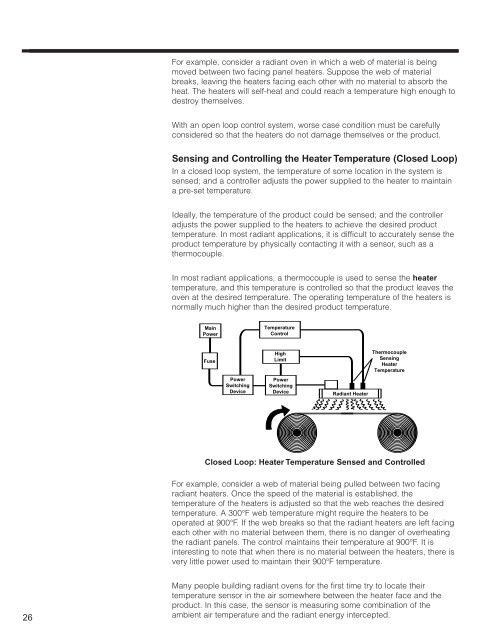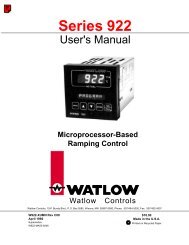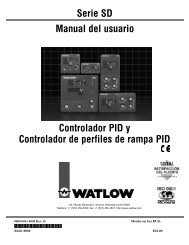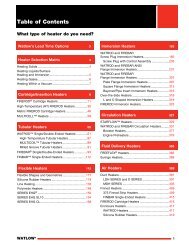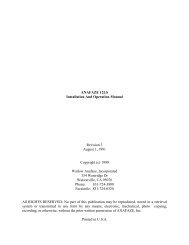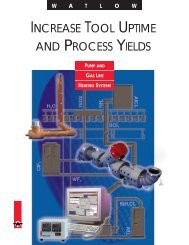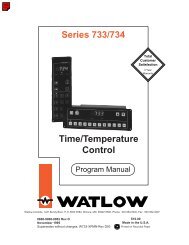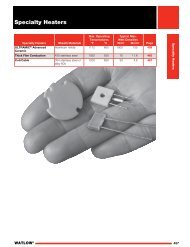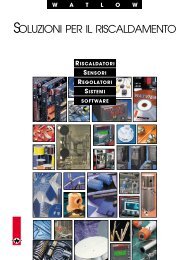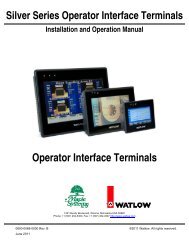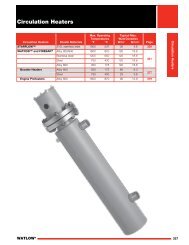RADIANT HEATING WITH INFRARED - Watlow
RADIANT HEATING WITH INFRARED - Watlow
RADIANT HEATING WITH INFRARED - Watlow
You also want an ePaper? Increase the reach of your titles
YUMPU automatically turns print PDFs into web optimized ePapers that Google loves.
26<br />
For example, consider a radiant oven in which a web of material is being<br />
moved between two facing panel heaters. Suppose the web of material<br />
breaks, leaving the heaters facing each other with no material to absorb the<br />
heat. The heaters will self-heat and could reach a temperature high enough to<br />
destroy themselves.<br />
With an open loop control system, worse case condition must be carefully<br />
considered so that the heaters do not damage themselves or the product.<br />
Sensing and Controlling the Heater Temperature (Closed Loop)<br />
In a closed loop system, the temperature of some location in the system is<br />
sensed; and a controller adjusts the power supplied to the heater to maintain<br />
a pre-set temperature.<br />
Ideally, the temperature of the product could be sensed; and the controller<br />
adjusts the power supplied to the heaters to achieve the desired product<br />
temperature. In most radiant applications, it is difficult to accurately sense the<br />
product temperature by physically contacting it with a sensor, such as a<br />
thermocouple.<br />
In most radiant applications, a thermocouple is used to sense the heater<br />
temperature, and this temperature is controlled so that the product leaves the<br />
oven at the desired temperature. The operating temperature of the heaters is<br />
normally much higher than the desired product temperature.<br />
Main<br />
Power<br />
Fuse<br />
Power<br />
Switching<br />
Device<br />
Temperature<br />
Control<br />
High<br />
Limit<br />
Power<br />
Switching<br />
Device<br />
Radiant Heater<br />
Thermocouple<br />
Sensing<br />
Heater<br />
Temperature<br />
Closed Loop: Loop: Heater Heater Temperature Temperature Sensed and Sensed Controlledand<br />
Controlled<br />
For example, consider a web of material being pulled between two facing<br />
radiant heaters. Once the speed of the material is established, the<br />
temperature of the heaters is adjusted so that the web reaches the desired<br />
temperature. A 300°F web temperature might require the heaters to be<br />
operated at 900°F. If the web breaks so that the radiant heaters are left facing<br />
each other with no material between them, there is no danger of overheating<br />
the radiant panels. The control maintains their temperature at 900°F. It is<br />
interesting to note that when there is no material between the heaters, there is<br />
very little power used to maintain their 900°F temperature.<br />
Many people building radiant ovens for the first time try to locate their<br />
temperature sensor in the air somewhere between the heater face and the<br />
product. In this case, the sensor is measuring some combination of the<br />
ambient air temperature and the radiant energy intercepted.


